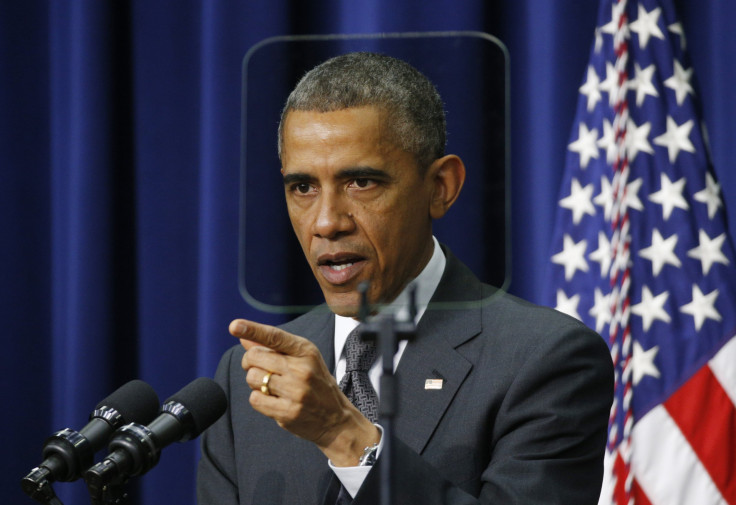Does The CIA Still Torture Suspects? Senate Report Raises Questions About Obama Administration Policies

As President Barack Obama and top government officials voice concerns at the findings of the newly released Senate report on CIA torture, experts say the Obama administration is not doing enough to stamp out policies that enable such tactics to continue. The troubling lack of oversight over the CIA revealed in the report, released Tuesday, also suggests it could be difficult to ensure that U.S. intelligence agencies will follow any new official guidelines.
Despite Obama’s 2009 executive order banning the use of torture by the CIA and the subsequent closing of the agency’s black sites, loopholes remain in place that allow for such practices to continue in certain circumstances, said Dr. Rebecca Gordon, a lecturer in philosophy at the University of San Francisco in California and the author of a book on U.S. torture in the post-9/11 era. “The executive order didn't touch any other agencies, and that particularly includes the Joint Special Operations Command, which ran its own secret detention sites,” she said. The clandestine force of the U.S. military continues to operate around the world and has been used more aggressively in the past decade than ever before, according to Business Insider.
Another notable loophole in the order is that the CIA has been allowed to maintain short-term transitory sites in order to detain terrorism suspects. “We don’t know what that means or what the CIA can do at these sites,” said Naureen Shah, the director of the security and human rights program at Amnesty International USA. That this practice was allowed to continue even after the executive order effectively allows for the continuation of the CIA’s extraordinary rendition program, an extra-legal transfer of detainees into the custody of foreign governments.
“The shift on torture [under Obama] means that generally the administration is not interested in being in the business of detaining people,” said Shah. Instead, “they are cooperating in the detention and secret detentions -- that often involve kidnappings-- with other governments.” At least 54 countries have participated in the CIA’s rendition program, according to a 2013 report by the Open Society Foundation. Whether all 54 were complicit in the torture program is debatable. However, as Max Fisher pointed out at Vox, the continuation of the rendition program likely means that the scale of torture undertaken by the CIA was even greater than the Senate report noted.
Following the report’s publication by the Senate Intelligence Committee, Obama called the agency’s techniques “contrary to who we are” in an interview with MSNBC and offered his assurances that similar intelligence-gathering methods were no longer in use. The extensive report detailed grisly tactics employed against detainees, including waterboarding, sleep deprivation and rectal feeding.
"I've been very explicit about how our intelligence gathering needs to conduct itself, and explicitly prohibited these kinds of techniques," he said. "Anybody who was doing the kinds of things that are described in the report would not simply be keeping something from me, they would be directly violating the orders that I've issued as president and commander in chief."
Despite Obama’s confidence, the staggering revelations about the CIA raised serious questions about its culture of torture. The Senate report revealed not only that the brutal interrogations during the Bush presidency were largely ineffective in yielding actionable information but also that the agency deliberately misled Congress and the White House about its interrogation methods and their results.
“There is still the looming question of whether you can control the intelligence agencies in this country,” said Karen Greenberg, director of the Center on National Security at Fordham Law School in New York. The issue of oversight remains a major one despite the forceful stance the Obama administration has taken against torture, she said.
There’s a genuine commitment to the prohibition of torture within the Obama administration, according to Shah. However, “when you permit any government agency to operate in secrecy, you are risking abuse,” she said. “When you trust an agency that has a repeated pattern of committing abuse and covering it up, you are taking a huge risk in terms of human rights abuses.”
The president’s executive order is also not enough to ensure the agency won't conduct torture in the future, said Shah. “Congress has not passed a law banning the CIA from carrying out detentions... Even if it's banned now under the executive order, it's possible that under another administration the CIA could be entrusted with detaining people and we would see some sort of reversion,” she said.
Speculation about the CIA’s practices aside, the U.S. government is still detaining terror suspects at its Guantanamo Bay prison in Cuba, a glaring repudiation of Obama’s 2009 promise to erase the last vestiges of the Bush-era war on terror, national security experts said. While techniques used against Gitmo prisoners, including force-feeding, do not fit the official label of torture, that facility remaining open is “another one of those extra-legal, newly-legal categories that need to be addressed,” said Greenberg. “We still have 136 individuals at Guantanamo that need to have their rights restored, be released, or be charged.”
© Copyright IBTimes 2024. All rights reserved.






















